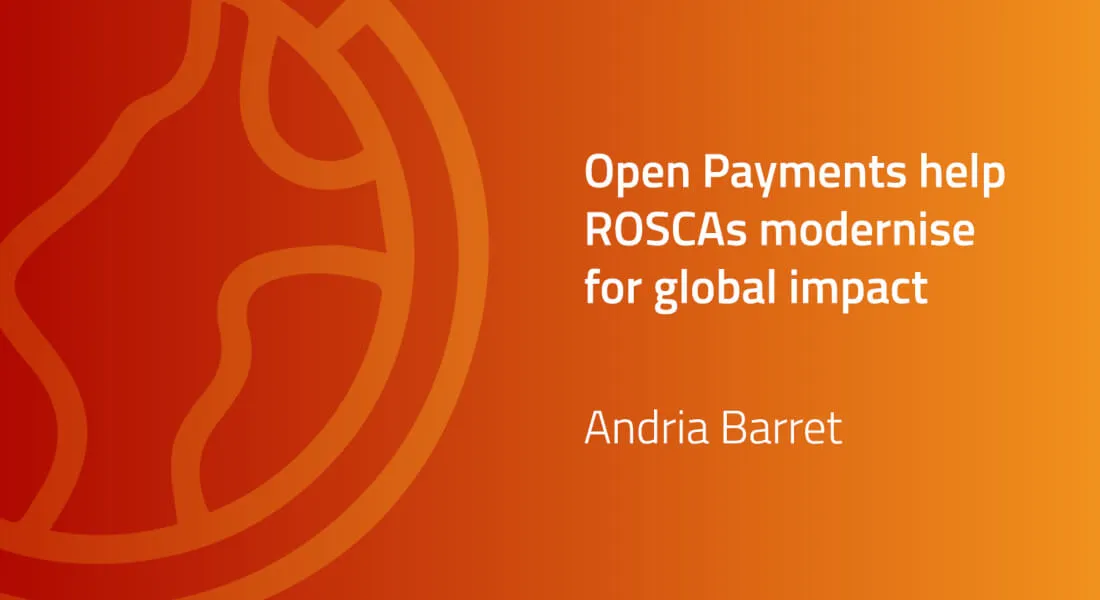
Open Payments help ROSCAs modernise for global impact
Technologies like blockchain and now, agentic AI, have transformed customer experiences and operational efficiencies in the traditional financial services industry. Now, Rotating Savings and Credit Associations (ROSCAs) are leaning into the same technologies to offer financial lifelines to global communities – especially women and immigrant communities.
Dating back more than 2000 years, ROSCAs are groups of individuals who act together as an informal financial institution. ROSCAs use a common fund to which individuals contribute a regular fixed amount (usually monthly), with one member withdrawing the funds at each meeting. These informal financial groups are particularly popular in the emerging economies and amongst migrants in developed countries and are believed to amount to more than $500 billion in value raised worldwide.
While ROSCA is the name most often used in academia, the concept is as rich and varied as the countries in which they operate. In Jamaica, they are called a “pardna”, in Nigeria, a “susu”. In Guyana, they are called a “box-hand” and in South Africa, a “stokvel”. No matter the nomenclature, they are all built on trust, mutual aid, and the power of community.
For Andria Barrett, a 2025 Interledger Foundation Ambassador, the journey from her family’s roots in Jamaica to her current work in Canada has been shaped by her vision to bring all the benefits of ROSCAs into the digital age.
“I remember my grandmother and her neighbours getting together every two weeks, putting their dollars together and it being wrapped up and hidden under the mattress. Then it was my mom’s turn and, while they were still gathering for a meal, the deposits were going into a bank account. Now the grandchildren of ROSCA users are taking things online, contributing from countries across the globe,” she shares. This tradition, passed down through generations, is more than a financial tool, Barrett says it is a source of social cohesion, resilience, and empowerment.
Despite their simplicity, the cultural and social significance of ROSCAs continue to make their mark, particularly amongst those excluded from formal banking systems.
Barrett explains that ROSCAs are used to save, invest and build businesses and enjoy strong support from women and migrant workers who have taken the culture of collective saving to their new countries.
Open payments revolutionise a centuries-old system
In an increasingly digital world, it was clear that ROSCAs would need a makeover. Younger generations, accustomed to managing every aspect of their lives through smartphones and apps, are naturally inclined to seek digital solutions for saving and investing. At the same time, the global diaspora, whether for work, education, or family, means that traditional, location-based ROSCAs are no longer sufficient to meet the needs of today’s communities.
Borderless payments a priority
Barrett says digitalising ROSCAs is not simply a matter of convenience, but the best way to extend their reach and impact.
“By moving ROSCAs online, it becomes possible for members scattered across different countries and continents to participate in the same group, pooling their resources and supporting each other’s goals regardless of geographic boundaries. This inclusivity is especially important for immigrant communities, who often maintain strong ties to their countries of origin and wish to support family and friends from abroad,” she says.
Barrett believes the real game-changer in this digital evolution is the advent of Open Payments technology.
Open Payments, enabled by protocols like the Interledger Protocol (ILP), will allow for seamless, secure, and low-cost transactions across different financial networks and currencies. This means that ROSCA members would be able to contribute and receive funds in their local currencies, without the friction and expense of traditional remittance systems. This ability to move money quickly and affordably across borders would remove one of the biggest barriers to global participation in ROSCAs.
Open Payments would also bring a new level of transparency and security to ROSCA operations. Blockchain technology already creates an immutable record of all transactions, ensuring that every contribution and payout is visible and verifiable. This would help build trust, especially in an environment where members can no longer have the monthly in-person meetings.
“For communities that have historically been wary of formal financial institutions, the assurance of security and traceability is a significant step forward,” Barrett explains.
Platforms for future innovation
Open Payments enable the development of sophisticated digital ROSCA platforms that can offer features beyond what was possible in the traditional model. Automated payments, multi-currency support, real-time notifications, and integration with other financial tools can make participation easier and more attractive, especially for younger users.
Collaborative work amongst the Interledger community will also allow for the integration of ROSCAs with broader financial and fintech services. This hybrid approach can offer additional benefits such as savings accounts or credit scoring.
What’s more, the incorporation of social features such as messaging, video calls, and community forums also help preserve the sense of connection and mutual support that is at the heart of ROSCAs.
Looking to the future, Barrett says she is determined to preserve the spirit of mutual aid and community that has defined ROSCAs for generations, while harnessing all the power of digital innovation, and open payments in particular.
“Collaborative efforts are the best way to make ROSCAs more accessible, secure, and impactful. We know that women and immigrants are often excluded from mainstream financial services, but digital ROSCAs will go a long way to help them gain access to new opportunities for financial empowerment and independence – which is exactly what ROSCAs have always represented,” she says.
Read more in her report and learn more about our Ambassador program.